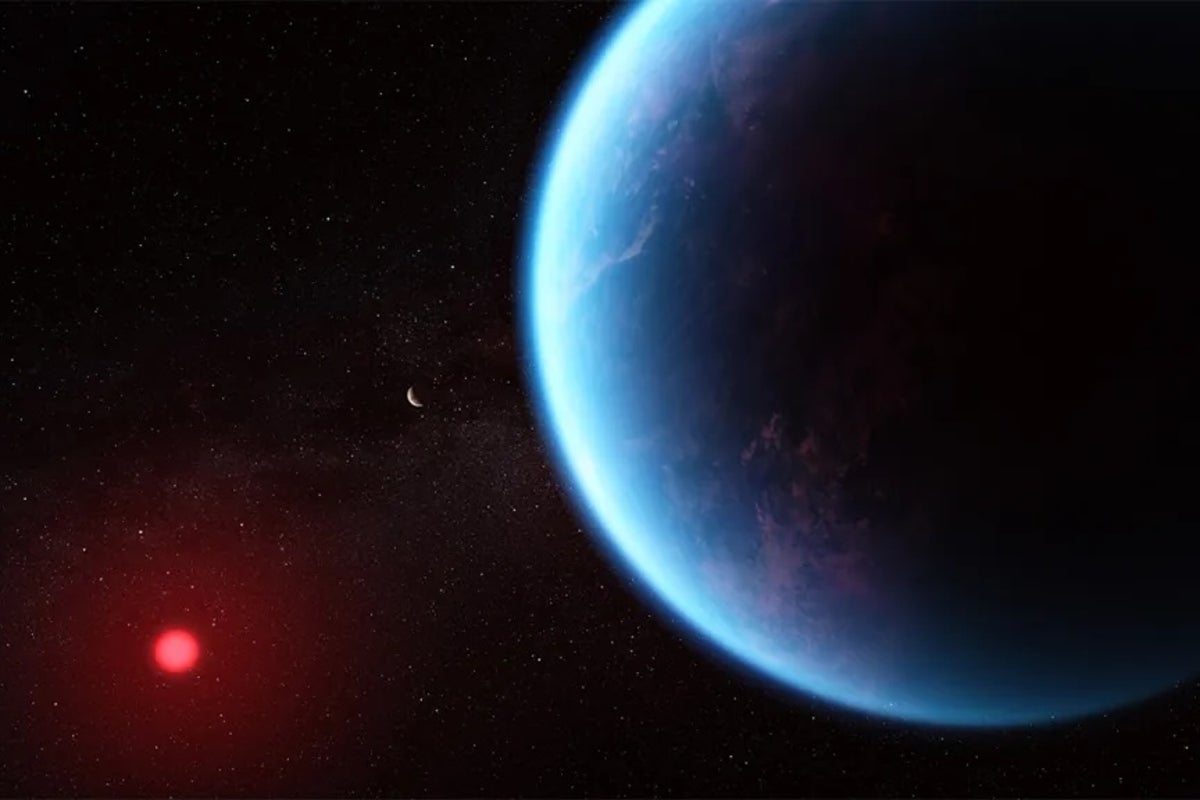
It’s one of humanity’s oldest questions. Are we alone? Is there life elsewhere in our galaxy or the universe?
Scientists last week made a stunning announcement that they had found the “strongest evidence yet” of life beyond our solar system. A team of astronomers using NASA’s James Webb Space Telescope said they had detected the chemical fingerprints of the compound dimethyl sulfide and dimethyl disulfide in the atmosphere of the exoplanet K2-18b.
On Earth, dimethyl sulfide is produced by microbial life, like phytoplankton that live in our oceans. Past observations of K2-18b had marked the first time carbon-based molecules were discovered in the atmosphere of an exoplanet in the habitable zone of its star. Scientists said that their findings indicate the possibility of a “hycean” world with an ocean “teeming with life.”
They also said that they needed more data.
“It’s important that we’re deeply skeptical of our own results, because it’s only by testing and testing again that we will be able to reach the point where we’re confident in them,” noted University of Cambridge Professor Nikku Madhusudhan, who lead the research team.
“Any claim of life on another planet requires a lot of justification, and I don’t think we’re there yet, Måns Holmberg, a researcher at the Space Telescope Science Institute who was part of the group announcing the findings, told NPR.
Other scientists have since voiced their skepticism regarding the conclusions.
“The new JWST observations of K2-18b do not provide any real evidence that potential biosignature gases (i.e. DMS or DMDS) are present. Many exoplanet astronomers, myself included, have severe concerns about the gap between the very low statistical significance in the new study — which would be considered a non-detection for any other planet — and the definitive statements being made by the science team,” Dr. Ryan MacDonald, an astrophysicist at the University of Michigan, told The Independent.
“The previous claim of DMS in K2-18b’s atmosphere in 2023 was not reproduced when that JWST data was re-analyzed by an independent team, so I wouldn’t hold my breath,” he added.
“When it comes to K2-18 b, enthusiasm is outpacing evidence,” cautioned Dr. Sara Seager, a professor at MIT who was once Madhusudhan’s graduate adviser.
“Right now, independent teams have completely different interpretations of what the planet even is: some propose a hycean world, others suggest a hot magma ocean — a planet with molten rock beneath a hydrogen-rich atmosphere, which is about as inhospitable as it gets — and still others see it as a mini-Neptune.”
The SETI Institute, a non-profit working to understand the origins and prevalence of life and intelligence in the universe, wrote in a release: “The claim is intriguing, as these gases can be associated with biological activity. On the other hand, the signal is modest, ambiguous, and potentially explainable as the result of noise or systematic error.”
Moreover, “abiotic sources for these compounds do exist, and even if they are low-yield and short-lived, they cannot yet be ruled out. Critically, contextual data about the planet remain limited, making interpretation of atmospheric signatures highly uncertain,” the SETI statement added. Abiotic means something that is a non-living part of an ecosystem.
Edward Schwieterman, an astrobiologist at the University of California, Riverside, echoed that concern.
“The planetary context is what matters,” he told Nature. If the molecules really are in the planet’s atmosphere, he noted, “we have to brainstorm novel ways of producing a lot of it through abiotic means and evaluate those possibilities before accepting it as evidence for life.”
Researchers told Nature that there are questions about whether the planet even has water, if the dimethyl sulfide is present, or if the biosignature molecules are just due to chance. The Cambridge researchers argue that there is just a 0.3 percent probability that they are chance-based.
“I think this is one of those situations where extraordinary claims require extraordinary evidence,” Laura Kreidberg, an astronomer at the Max Planck Institute for Astronomy in Germany, told NPR. “I’m not sure we’re at the extraordinary evidence level yet.”
All of this is not to say there’s no merit in the incredibly difficult work. SETI says it helps to nail down what further research is needed to test the claims.
NASA noted the detection of a single potential biosignature would not constitute the discovery of life, and that follow-up studies and multiple converging lines of evidence would be needed to rule out false positives.
“Searching for life beyond Earth is one of the great, profound pursuits of humankind. But any claim of life out there will require thorough study by the scientific community as a whole before we have confidence in the results,” said Dr. Bruce Betts, chief scientist at The Planetary Society.
Source: independent.co.uk


